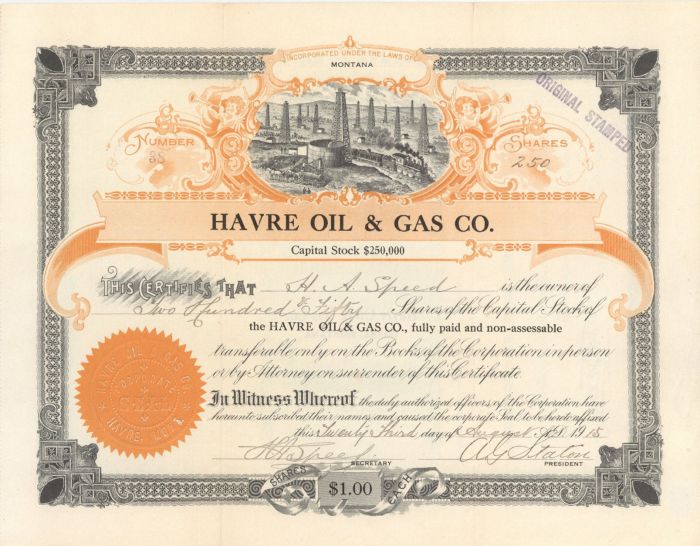Havre Oil and Gas Co. - Montana Oil Stock Certificate
Inv# OS1779 Stock
Stock. Havre was incorporated in north-central Montana on 5 September 1893. In August 1893, twenty-six people voted to incorporate Havre as a city on September 5 of that year. The townsite was platted south of the railroad tracks on parts of Descelles’ and Simon Pepin’s ranches. Like many railroad towns, Havre’s streets were set in a grid formation, with the east–west orientation of the railroad serving as the northern boundary of the town running parallel to the south by Main Street, which fronted the railroad tracks, followed by First through Third Streets. The avenues ran perpendicular to the tracks with Third Avenue running south from the Great Northern depot. The depot served as the gateway to the commercial district of Havre. First Street between Second Avenue and Fourth Avenue served as the main commercial street, and Third Avenue became the main avenue. The buildings in Havre during the 1890s were typical first-generation structures and mainly consisted of tar papered wood-framed shacks. Built close together, these buildings were false-fronted and one story high, with a few scattered one-and-a-half and two-story buildings, like the Windsor Hotel on the south side of First Street between Third and Fourth Avenues.
Along with its annex, the Windsor, at two stories, was the tallest building on First Street until brick structures were constructed in the mid-1890s. Havre had many businesses typical of a frontier town including saloons, barbers, restaurants, Chinese laundries, cobblers, bakeries, mercantiles, hardware stores, and hotels. Havre was founded primarily to serve as a major railroad service center for the Great Northern Railway built by James J. Hill with the city's location midway between Seattle and Minneapolis-St. Paul. A statue of Hill stands near the Havre Amtrak station to commemorate the key contributions his railroad has made to Havre's and Montana's history. Next to the station on display is Great Northern S-2 Class #2584, a 4-8-4 "Northern" type steam locomotive that served the station while it was in passenger service.
A stock certificate is issued by businesses, usually companies. A stock is part of the permanent finance of a business. Normally, they are never repaid, and the investor can recover his/her money only by selling to another investor. Most stocks, or also called shares, earn dividends, at the business's discretion, depending on how well it has traded. A stockholder or shareholder is a part-owner of the business that issued the stock certificates.









Ebay ID: labarre_galleries